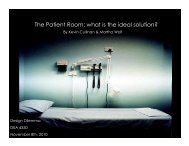The role of physical design and informal communication
The role of physical design and informal communication
The role of physical design and informal communication
You also want an ePaper? Increase the reach of your titles
YUMPU automatically turns print PDFs into web optimized ePapers that Google loves.
nursing unit ecosystem <strong>and</strong> its web <strong>of</strong> interacting components <strong>and</strong> not by factors that<br />
operate mutually exclusive <strong>of</strong> one another.<br />
4.8 Study Limitations<br />
<strong>The</strong> small sample size <strong>of</strong> one GN limits the extent to which conclusions can be<br />
generalized to other GNs <strong>and</strong> settings. It is important to note that the original<br />
methodology for this study included a sample <strong>of</strong> 10-12 GNs to be shadowed on<br />
nursing units with differing layouts. However, because the available pool <strong>of</strong> incoming<br />
graduate nurses was much smaller than expected, it was possible to shadow only one<br />
GN. Despite this limitation, the study’s value lies in the fact that it is an exploration <strong>of</strong><br />
the nursing unit ecosystem as an integrated workplace with diverse care providers, not<br />
<strong>of</strong> a single graduate nurse. <strong>The</strong> validity <strong>of</strong> these findings are also strengthened, as<br />
noted earlier, by other research reporting similar results.<br />
In order to protect patient privacy, data was not collected in patient rooms.<br />
<strong>The</strong>refore, unique interaction patterns that perhaps did not occur outside <strong>of</strong> the patient<br />
room could have been missed. One significant daily event that was never captured<br />
was unit rounds, where the care team gathers in each patient room to share<br />
information, address patient concerns, <strong>and</strong> formulate or revise the care plan. Manias<br />
<strong>and</strong> Street (2001) cite many studies involving nurse–doctor interactions during the<br />
ward round that have identified nurses' passivity <strong>and</strong> their lack <strong>of</strong> confidence about<br />
asserting themselves in discussions. Not only could rounds have been prime occasions<br />
for GN on-the-job learning interactions, which would have been missed, but they also<br />
would have provided insight into GN-doctor interactions <strong>and</strong> the extent to which these<br />
progressed, if at all, over the course <strong>of</strong> orientation. CWM data shows that only two<br />
percent <strong>of</strong> all interactions occurred with doctors, yet there is no way <strong>of</strong> knowing if this<br />
small percentage was <strong>of</strong>fset by those taking place inside patient rooms or elsewhere,<br />
117







